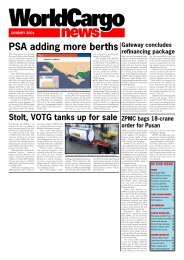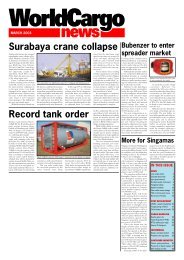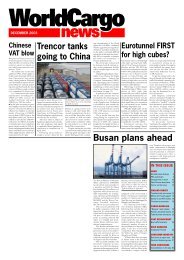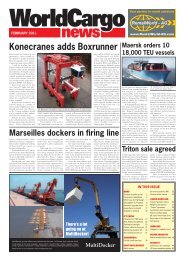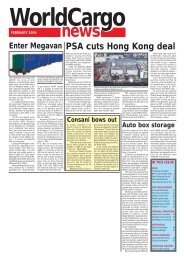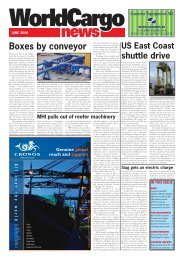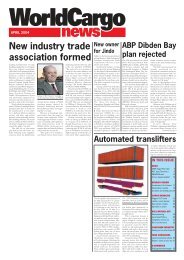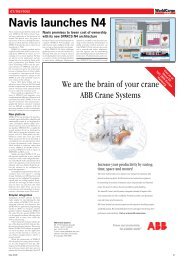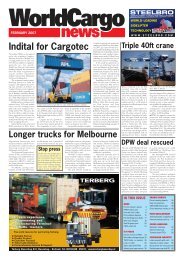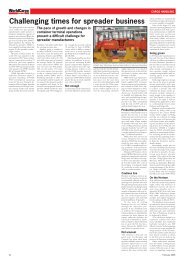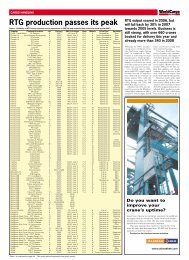Tanjung Priok super port - WorldCargo News Online
Tanjung Priok super port - WorldCargo News Online
Tanjung Priok super port - WorldCargo News Online
You also want an ePaper? Increase the reach of your titles
YUMPU automatically turns print PDFs into web optimized ePapers that Google loves.
PORT DEVELOPMENT<br />
Looking to fulfil their potential<br />
In theory the two parts of the Zeeland<br />
Sea<strong>port</strong>s, Terneuzen and Vlissingen, are<br />
well placed on either side of the Scheldt<br />
estuary to take advantage of capturing<br />
some of Antwerp’s deep sea traffic. In<br />
practice, this does not appear to be the<br />
case and the <strong>port</strong>s serve their respective<br />
hinterlands, particularly the industries attracted<br />
to this region of Holland. There is<br />
considerable barge traffic between<br />
Zeeland <strong>port</strong>s and Antwerp and further<br />
into the Belgium/Dutch canal network,<br />
but mainly for domestic cargoes.<br />
Last year Zeeland Sea<strong>port</strong>s (ZSP) recorded<br />
a 4% drop in overall seagoing tonnage<br />
to 34 Mt, although CEO Hans van<br />
der Hart notes that “mid 2012, we were<br />
down 8%, so the figures were quite satisfactory<br />
in the end, especially when we<br />
take results of surrounding <strong>port</strong>s into consideration.”<br />
Barge traffic increased 12%,<br />
taking total volumes to around 70 Mt.<br />
ZSP wants to increase seaborne cargo<br />
to 50 Mtpa and inland shipping throughput<br />
to 40 Mt by 2020. To achieve this, the<br />
<strong>port</strong> argues, it will need a deep sea container<br />
terminal. The <strong>port</strong>s already handle<br />
some containers, with tonnage increasing<br />
7% last year to 202,000t. Most containers<br />
are handled at the Katoen Natie<br />
shortsea/barge terminal located adjacent<br />
to the large Dow Chemicals plant at<br />
Terneuzen, which provides the main<br />
cargo source, with very little third party<br />
traffic accommodated.<br />
Looking west<br />
Van der Hart is confident that “container<br />
handle will remain a spearhead [of <strong>port</strong><br />
strategy]. The Westerschelde Container<br />
Terminal project (WCT) is still in the picture.<br />
In the meantime, together with other<br />
companies, we are looking at possibilities<br />
to realise a terminal within the existing<br />
docks. This is really im<strong>port</strong>ant.”<br />
The CCO, Dick Gilhuis, endorses this:<br />
“We are convinced that containerisation<br />
is necessary for the growth of all trade<br />
and industry. Therefore, we have to think<br />
about container facilities in our <strong>port</strong>.”<br />
However, Gilhuis noted that he was not<br />
talking about facilities on the scale of<br />
WCT, but about a smaller scale container<br />
terminal in Vlissingen.<br />
“A WCT-scale facility will become<br />
im<strong>port</strong>ant longer term. We have to have<br />
such a terminal to serve our customers in<br />
a better way. A small terminal will handle<br />
around 500,000 TEU. ” According to the<br />
CCO, negotiations with various parties<br />
are looking quite promising.<br />
Gilhuis calculates that current northern<br />
European container handling capacity<br />
is around 60M TEU, which will increase<br />
to around 100M TEU by 2020.<br />
“Looking at these figures, one may wonder<br />
whether we still have to develop a<br />
major container terminal, such as WCT.<br />
That is why we will not embark upon<br />
such a venture yet. But a terminal is built<br />
to last for 40 years or so. If we stop the<br />
plans now, we will come up against quite<br />
another problem in the future.”<br />
Tactical withdrawal<br />
These cautious remarks reflect what is actually<br />
happening on the ground. The partners<br />
behind the Scaldia Terminal Operator<br />
(STO) container terminal have pulled<br />
out of the venture, stating that “the market<br />
we aimed at has collapsed...As the recession<br />
spread, container lines became<br />
ever more reluctant to move to Flushing.”<br />
STO was to be established on a 55-<br />
ha site by the Antwerp-based stevedoring<br />
company Zuidnatie in conjunction with<br />
the Ghent-based group Sea-Invest, with<br />
the latter holding a 70% stake.<br />
It is widely anticipated that the dominant<br />
Zeeland operator, Verbrugge, which<br />
last year handled over 15 Mt at the two<br />
<strong>port</strong>s, will take at least 13-ha of the site<br />
earmarked for STO, to which it may add<br />
at a later date (see also p56). Verbrugge recently<br />
secured a major contract to handle<br />
cellulose im<strong>port</strong>s from Eldorado Brazil<br />
Cellulose, which recently commissioned<br />
the largest single-line pulp mill in<br />
the world, with a capacity of 1.5 Mtpa.<br />
A substantial part of this will shipped<br />
from Santos, Brazil to the Scaldiahaven<br />
in Vlissingen, where it will be stored and<br />
subsequently trans<strong>port</strong>ed to the paper and<br />
Mainstream container handling remains<br />
an elusive target for Zeeland Sea<strong>port</strong>s<br />
tissue industries in the hinterland.<br />
Verbrugge will act as the European logistics<br />
hub for this traffic. It secured the<br />
contract in the face of strong competition,<br />
particularly from Antwerp.<br />
Invest at the bottom<br />
Despite the financial crisis and the economic<br />
recession, Verbrugge Terminals<br />
continues to investing substantially in its<br />
Vlissingen and Terneuzen sites. Last year,<br />
the operator invested €45M in expanding<br />
its terminal in Terneuzen, while in<br />
2011 similar amounts were put towards<br />
the expansion of Verbrugge Terminals in<br />
the new Scaldiahaven in Vlissingen, where<br />
Verbrugge was the first operator.<br />
Since 2007, the company has invested<br />
€165M in its facilities at both <strong>port</strong>s. In<br />
all, Verbrugge has three terminals in<br />
Vlissingen and Terneuzen, comprising<br />
over 1M m 2 of covered storage facilities.<br />
Typical bulk handling operation in Terneuzen<br />
Prevent this<br />
By getting this<br />
Cascade’s HFC<br />
(Hydraulic Force Control)<br />
<strong>WorldCargo</strong><br />
news<br />
HFC from Cascade is a cost effective damage reduction solution that<br />
automatically prevents over-clamping due to excessive clamp force.<br />
Easy to install and transparent to the driver, Cascade’s HFC will enable every<br />
operator to apply the correct amount of clamp force to handle a paper roll<br />
without damage.<br />
Make all your drivers experts today.<br />
North America: 800 CASCADE (227-2233) • Europe: 0039 (0) 45 8989 111<br />
www.cascorp.com<br />
Scan to see a video<br />
demonstration.<br />
May 2013 43



